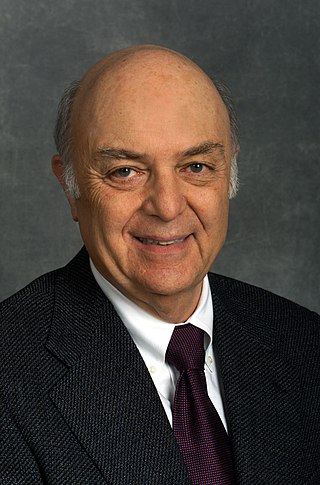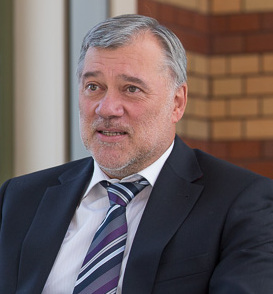Related Research Articles
Jozef T. Devreese was a Belgian scientist, with a long career in condensed matter physics. He was professor emeritus of theoretical physics at the University of Antwerp. He died on November 1, 2023.
Harry L. Swinney is an American physicist noted for his contributions to the field of nonlinear dynamics.

Marvin Lou Cohen is an American–Canadian theoretical physicist. He is a physics professor at the University of California, Berkeley. Cohen is a leading expert in the field of condensed matter physics. He is widely known for his seminal work on the electronic structure of solids.

Xiao-Gang Wen is a Chinese-American physicist. He is a Cecil and Ida Green Professor of Physics at the Massachusetts Institute of Technology and Distinguished Visiting Research Chair at the Perimeter Institute for Theoretical Physics. His expertise is in condensed matter theory in strongly correlated electronic systems. In Oct. 2016, he was awarded the Oliver E. Buckley Condensed Matter Prize.
Daniel L. Stein is an American physicist and Professor of Physics and Mathematics at New York University. From 2006 to 2012 he served as the NYU Dean of Science.

David R. Nelson is an American physicist, and Arthur K. Solomon Professor of Biophysics, at Harvard University.
Manfred Lindner is a German physicist and director at the Max Planck Institute for Nuclear Physics in Heidelberg, Germany. He conducts basic research in particle and astro-particle physics.
Eric R. Weeks is an American physicist. He completed his B.Sc. at the University of Illinois at Urbana–Champaign in 1992. He obtained a Ph.D. in physics from the University of Texas at Austin in 1997, working under Harry Swinney, and later completed post-doctoral research with David Weitz and Arjun Yodh at Harvard University and the University of Pennsylvania. He is currently a full professor at Emory University in Atlanta, Georgia.

Jürgen Kurths is a German physicist and mathematician. He is senior advisor in the research department Complexity Sciences of the Potsdam Institute for Climate Impact Research, a Professor of Nonlinear Dynamics at the Institute of Physics at the Humboldt University, Berlin, and a 6th-century chair for Complex Systems Biology at the Institute for Complex Systems and Mathematical Biology at Kings College, Aberdeen University (UK). His research is mainly concerned with nonlinear physics and complex systems sciences and their applications to challenging problems in Earth system, physiology, systems biology and engineering.
Stephan W. Koch was a German theoretical physicist. He was a professor at the University of Marburg and works on condensed-matter theory, many-body effects, and laser theory. He is best known for his seminal contributions to the optical and electronic properties of semiconductors, semiconductor quantum optics, and semiconductor laser designs. Major portion of his research work has focused on the quantum physics and application potential of semiconductor nanostructures. Besides gaining fundamental insights to the many-body quantum theory, his work has provided new possibilities to develop, e.g., laser technology, based on accurate computer simulations. His objective has been to self-consistently include all relevant many-body effects in order to eliminate phenomenological approximations that compromise predictability of effects and quantum-device designs.
David G. Grier is an American physicist whose research focuses on experimental soft condensed matter physics—an interdisciplinary field that includes physics, chemistry, biology, and nanotechnology, aiming to understand how objects interacting in simple ways manage to organize into sophisticated hierarchies of structure and function.
James Michael Lattimer is a nuclear astrophysicist who works on the dense nuclear matter equation of state and neutron stars.

Louis Franklin DiMauro is an American atomic physicist, the Edward and Sylvia Hagenlocker Professor In the department of physics at the Ohio State University, Columbus, Ohio, USA. His interests are atomic, molecular and optical physics. He has been elected a Fellow of the American Association for the Advancement of Science, American Physical Society and Optical Society.
Terry Schalk is an American physicist currently professor emeritus at University of California, Santa Cruz and an Elected Fellow of the American Association for the Advancement of Science.
Anatoly Boris Kolomeisky is a professor of Chemistry, Chemical and Biomolecular Engineering, Physics and Astronomy and chairman of the department of Chemistry at Rice University in Houston, Texas.
Gregor Eugen Morfill is a German physicist who works in basic astrophysical research and deals with complex plasmas and plasma medicine.
Patrick Mora is a French theoretical plasma physicist who specializes in laser-plasma interactions. He was awarded the 2014 Hannes Alfvén Prize and 2019 Edward Teller Award for his contributions to the field of laser-plasma physics.
Toshiki Tajima is a Japanese theoretical plasma physicist known for pioneering the laser wakefield acceleration technique with John M. Dawson in 1979. The technique is used to accelerate particles in a plasma and was experimentally realized in 1994, for which Tajima received several awards such as the Nishina Memorial Prize (2006), the Enrico Fermi Prize (2015), the Robert R. Wilson Prize (2019), the Hannes Alfvén Prize (2019) and the Charles Hard Townes Award (2020).
Sergei Vladimirovich Bulanov, is a Russian physicist. He received the 1983 State Prize of the USSR, the 2016 Hannes Alfvén Prize for "contributions to the development of large-scale next-step devices in high-temperature plasma physics research", and the Order of Rising Sun with Gold Rays and Rosette in 2020.

Matthieu Wyart is a French physicist. He is a professor of physics at EPFL and the head of the Physics of Complex Systems Laboratory.
References
- ↑ Biography - Arizona State University Archived 2014-07-14 at the Wayback Machine
- ↑ Biography - Personal Homepage
- ↑ H. He, M. F. Thorpe Phys. Rev. Lett. 54 (1985) 2107, M. F. Thorpe et al. J. Non_Cryst. Sol.266-269 (2000)859
- ↑ Biography - Arizona State University Archived 2014-07-14 at the Wayback Machine